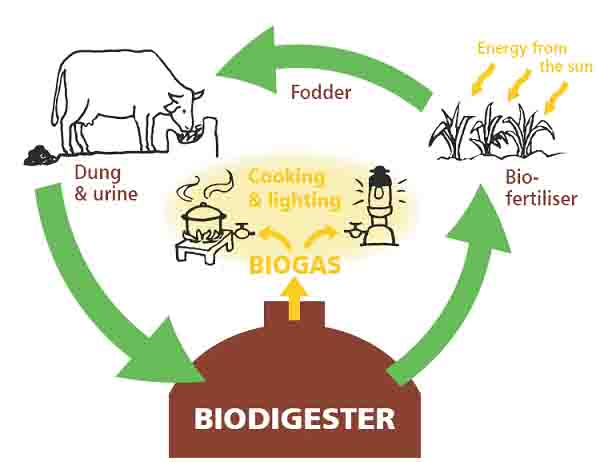
INSIDE the Zimbabwe Domestic Biogas Programme (ZDBP) information trailer, the flame on the biogas stove suddenly flares and flickers as if blown by the wind. The mobile information trailer, designed to resemble a kitchen, is connected to a biogas digester built underground, which converts cow dung into biogas that can be used for cooking, heating and lighting.
BY MASIMBA BIRIWASHA
Upon seeing the dancing flames, Sibongile Mandarira (35), a teacher based in Masvingo, lights up.
“Until today, I had only read about biogas technology, but this experience is a real eye opener. I saw how it actually works. I’ve already made my mind up to install a digester at my rural home because it is smart,” she said, the brightness of her eyes betraying her curiosity.
“I will use biogas for breeding chickens and lighting chicken runs. I will also use it for cooking and refrigeration.”
Mandarira said that prior to visiting the information trailer, which was stationed at the Rural Electrification Agency (REA) exhibition stand at the recently-ended Zimbabwe International Trade Fair (ZITF) she did not know much about biogas technology. Despite that biogas has great potential to increase access to clean, reliable and affordable energy in Zimbabwe, particularly in rural areas, the technology remains novel to many people.
Against this background, the domestic biogas programme, a five-year initiative involving the Ministry of Energy and Power Development, Ministry of Agriculture, Mechanisation and Irrigation Development, Rural Electrification Agency, Netherlands Development Organisation (SNV) and Humanist Institute for Co-operation (Hivos) is employing the information trailer to demonstrate the efficiency of biogas in order to encourage uptake of the technology.
“Biogas is a very technical concept. Many people are not familiar with it despite its immense potential to provide energy for cooking, heating and lighting at domestic level. Merely talking about biogas without demonstrating how it works is not effective in encouraging people to take up the technology,” SNV’s renewable energy advisor Chandi Mutubuki-Makuyana, said. The domestic biogas programme is aimed at increasing access to sustainable, clean and reliable energy sources for domestic households and establishing a vibrant biogas sector that will benefit more than 67 000 households. The project follows a market-driven approach in promoting the dissemination of biogas technology. Biogas is a gas mixture that is predominantly made up of methane and carbon dioxide. It is created as a by-product when organic material decomposes in airless conditions. When the decomposition process occurs in an enclosed environment, it can be captured and used as a natural fuel source. The slurry left over from this process is an excellent organic fertiliser.
- Chamisa under fire over US$120K donation
- Mavhunga puts DeMbare into Chibuku quarterfinals
- Pension funds bet on Cabora Bassa oilfields
- Councils defy govt fire tender directive
Keep Reading
The use of biogas can be especially beneficial in rural areas, where there is no access to any other energy source and deforestation and indoor pollution are an issue. For people in rural areas, biogas is a much cleaner and environmentally-friendly alternative fuel source.
It burns with minimal carbon dioxide output and uses products that are readily available.
Potential environmental benefits include reduction of local pollutants, reduced deforestation due to logging for fuel and increased sequestration of carbon in soils.
With a minimum of five cows, it is possible to generate enough cow dung to feed a small sized digester. It costs approximately between $800 and $2 000 to construct a biogas digester.
“People are not so much interested in the digester itself in as much as what the gas can do. What the gas does is what excites people. We want to show people that with biogas nothing goes to waste. You get the gas from waste and you get slurry which is equivalent to Compound D fertiliser,” Mutubuki-Makuyana said.
A basic biogas digester consists of a tank in which the organic material is digested, combined with a system to collect and store the biogas produced.
The slurry of dung and water ferments in the tank and the pressure of the biogas produced pushes the slurry out of one end. The gas is piped from the top of the tank to a biogas cooking stove and biogas lights.
“Biogas changes people’s lives. Our outreach with the information trailer has been good because we are not talking about biogas theoretically. Most people cannot visualise it if you just tell them, but with the trailer we are conducting demonstrations. We hope to take the trailer from district to district and show people the advantages of biogas,” Mutubuki-Makuyana, adding that they would target households with cattle said.
According to Hivos Southern Africa Hub’s energy programme manager Soneni Ncube, the purpose of the information trailer is to inform the public about biogas as a cheap and modern form of energy.
“Biogas is clean, it produces no smoke, it is healthy and reduces the drudgery of labour faced by women and girls in looking for firewood. One can produce it from their own livestock and the slurry that comes out after manure is digested to produce biogas is a good fertiliser and is even better than raw manure,” Ncube said.
“Once people learn and see what they can do with biogas, it is hoped that this will increase the adoption rate of this form of energy as an alternative energy source for rural and peri-urban households instead of wood, thus reducing deforestation and reduction of carbon emissions into the atmosphere. This way it reduces the effects of climate change.”











